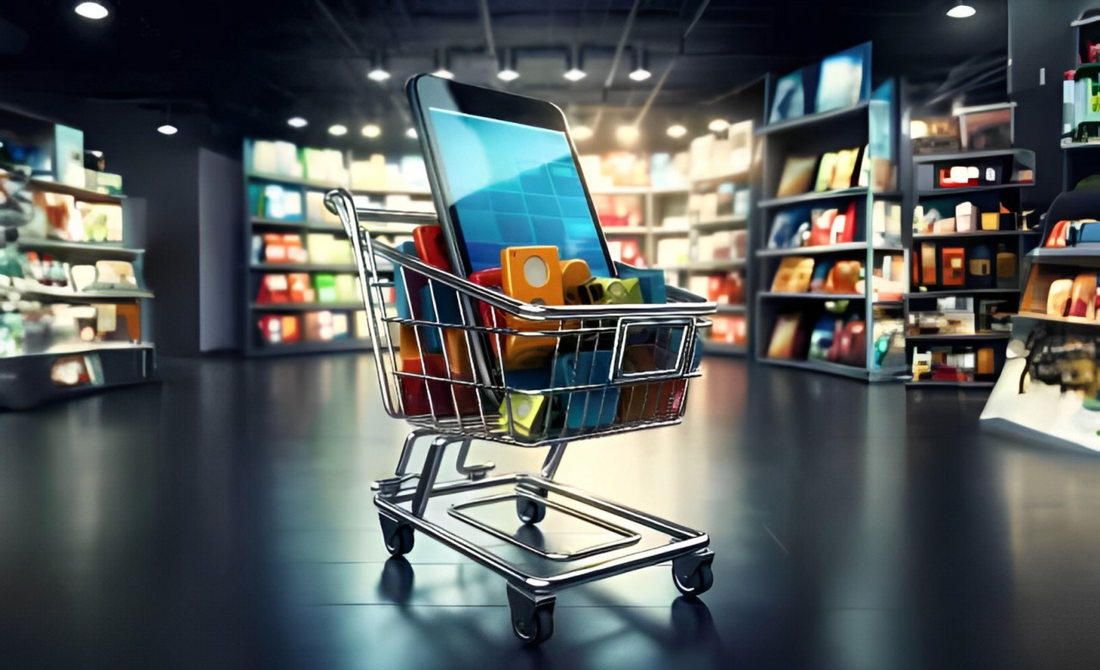Mobile Shopping: Shopify Tips to Capture the Mobile Market 2024
mobile market
mobile shopping
shopify
shopify tips

Mobile commerce is rapidly evolving into the preferred shopping method for most consumers and there are no signs of slowing down. Retail m commerce sales in the United States reached a staggering $491 billion in 2023 and are expected to reach $558 billion by 2024, making up 7.4% of all retail sales.
In fact, by the end of 2024, m commerce is expected to capture 44.6% of total U.S. retail sales—a staggering indicator of how central it has become in consumer shopping habits.
This increase is consistent with a major change in customer attitudes - 60% of American adults now believe that mobile shopping is necessary for a convenient online shopping experience.
However, despite its potential for growth, mobile shopping frequently creates difficulties. The inability of many retailers to optimize their mobile websites makes the customer experience less enjoyable.
A Basic Understanding of Mobile Commerce (m commerce)
M commerce, to put it simply, is the practice of purchasing and selling goods via wireless mobile devices. No matter where we are, mobile commerce allows us to buy the things we need, whether it's groceries for the week, a new pair of shoes, or an app subscription.
The following are some typical instances of m commerce transactions:
- Using a mobile browser to make a direct purchase on a website.
- Buying products or services from within an app, such as unlocking premium content or buying game items.
- Websites such as Amazon, Etsy, and eBay provide a wide variety of products in a single mobile application.
- Mobile transactions are made easy with fast and safe payments via Apple Pay, Google Pay, and Samsung Wallet.
But why m commerce have been taking over in recent years?
Well, the data says it all.
In the United States, mobile commerce is expected to reach $558 billion by 2024, making up 44.6% of all retail ecommerce sales. The trend towards mobile-first purchasing is being accelerated by the rapid adoption of 5G and modern phone technology as well as our society's growing reliance on mobile devices.
- Daily Mobile Usage: On average, US mobile users use their phones for three hours and fifteen minutes each day.
- Nomophobia: 97% of young individuals in a recent study said they had nomophobia, or fear of being cut off from mobile connectivity.
- Smartphone Addiction: People with smartphone addiction show withdrawal symptoms similar to other dependencies.
7 Mobile Commerce Tips To Capture Your Target Market
Well, there is no doubt that every person on this planet is now on their mobile phone. Failing to make your Shopify store mobile-friendly is going to put you at risk of losing your market to your competitors.
Let us discuss the 7 tips that you can capitalize on to gain dominance over the mobile market.
1.Have a ultra responsive mobile friendly Shopify store
In order to remain competitive, brands are putting more and more emphasis on designing mobile sites that are ultra-responsive. According to a recent Forrester survey, 23% of American consumers believe their screens are too small for easy purchasing, emphasising the necessity for firms to maximize mobile user experiences.
The significance of mobile-optimized websites is highlighted by the fact that, in Q4 of 2023, smartphones accounted for 54.67% of worldwide online traffic.
- Increase Mobile Loading Speeds: If a page takes too long to respond, you are likely to lose your customer. You can use Google PageSpeed Insights, a tool that analyses mobile loading speeds on average and makes recommendations for improvements. The goal is to achieve a perfect 100 score for optimal performance.
Prioritize Mobile-Friendly Design Elements Such As:
Large Buttons - Accommodate larger thumbs thus reducing frustration while browsing.
Fullscreen Product Images - Display products in vibrant detail, creating a more engaging shopping experience.
Hamburger Menus - Offer easy navigation which enables customers to toggle between page content and navigation with ease.
2.Use social commerce to drive sales
These days, social media is a bustling marketplace rather than just a platform to communicate! Social media sites like Facebook and Instagram are rapidly becoming essential for ecommerce, with 9.3% of users logging in each week to shop.
Brands are spending money on social media promotion and advertising strategies to capitalize on this trend. It helps them to increase mobile traffic and conversions on native commerce channels. These tactics include:
- Facebook Shops: 20.6% of US online buyers routinely use Facebook Shops, making it the most popular social shopping platform.
- Instagram Shopping: A visually-focused experience that's ideal for product browsing.
- Product Pins: Use Pinterest to get direct traffic to your products.
- Livestream Shopping: Brands can now display products and provide a direct link for immediate purchasing on social media sites like Facebook and Instagram.
3.One click ordering
It's true that less is more, as the average cart abandonment rate is 70.19%, frequently caused by excessively complicated checkouts. Simplify that process if you want to increase revenue from mobile customers!
To create a smooth, one-click mobile checkout, follow these steps:
- Quick Payments: One-tap checkout features are essential. Allow mobile-first payment options such as PayPal, Amazon Pay, Apple Pay, Android Pay, and Shop Pay.
- Know Your Audience: There's no need to overcomplicate things by selecting payment methods based on what your clients like. If your clientele can use traditional logins and credit cards, keep them accessible.
4.Include AR shopping tactics
Augmented Reality (AR) is becoming a standard for businesses of all kinds, particularly those seeking to improve customer experience and lower returns. It is no longer applicable only for luxury goods.
Virtual fitting rooms are a notable use of augmented reality that let buyers view things on themselves using their mobile devices. By superimposing a 3D model on a live video, the technology provides a realistic representation of how objects would appear and fit in the actual world.
Take IKEA’s Place app as an example. Customers can now see furniture in their homes before making a purchase, which helps them to make more informed selections. It significantly helps to reduce return rates as well.
Your Business can now show products in 360-degree views by using Shopify's 3D and AR model support. It gives customers a more interactive experience without leaving their homes.
5.Include mobile chatbots in your Shopify store
Customers are often reminded about products they left in their carts via emails. However, mobile are now chatbots establishing a niche for themselves in promoting consumer interaction, perhaps taking the place of or improving emails.
Finastra reports that in 2023, chatbots in mobile banking apps accounted for 79% of engagements, making them the primary route for chatbot-based client communication.
Companies benefit greatly from this change - With over 265 billion customer support queries yearly costing $1.3 trillion, chatbots are reducing expenses and improving customer experiences. It is anticipated that global chatbot income would surpass $454 million by 2027 thus highlighting their growing significance.
Take H&M for instance, whose chatbot, accessible via their app and website, answers questions from users regarding order tracking, product availability, and sizing. Customers can communicate with the chatbot to get answers and updates without ever leaving the app, whether they are looking for fashion tips or need assistance with order details.
6.Improve your omnichannel strategy
Mobile commerce is the foundation of a successful omnichannel strategy in today's retail environment, bridging the gap between online and offline purchasing. As of 2022, consumers engage across at least 11 touchpoints, and 70% spend more with brands that excel in omnichannel integration (Salsify report, 2022).
Here's a breakdown of how you can create an engaging experience across all channels:
Use Click-to-Mortar Incentives to Connect Online and In-Store
Connect digital and real-world experiences with ease using technology:
- QR Codes: Use QR codes to access in-store product information, reviews, and special offers.
- Geo-fenced SMS Coupons: As clients approach your store, send them location-based offers.
- Mobile Comparison Pages: Use comparison tools optimized for mobile phones and tablets to assist clients in rapidly weighing their options.
Simplify In-Store Checkouts with Mobile Support
Mobile point-of-sale (POS) platforms, such as Square and Shopify POS, shorten checkout times, cut down on lineups, and improve in-store experiences.
At stores like Decathlon, mobile checkout enables salespeople to help customers and finish transactions from anywhere in the shop, cutting down on wait times and increasing customer satisfaction.
Adopt Buy Online, Pick Up In-Store (BOPIS)
BOPIS, which is expected to generate $666 billion worldwide by 2028, provides convenience and boosts sales. Almost 50% of BOPIS clients make unforeseen purchases in addition to buying extra products during pickup.
Target's BOPIS option, for instance, has grown significantly, encouraging foot traffic and promoting more in-store sales.
Make NFC Payments Simpler for More Convenience
Implementing NFC (near-field communication) technology allows consumers to pay with a touch using mobile wallets like Apple Pay, which is advantageous for firms aiming to increase the number of mobile payment choices. Although there are setup fees, most retailers can manage the update since bulk pricing can lower these costs.
7.Implement voice search on your Shopify ecommerce store
Voice assistants such as Alexa and Siri have revolutionized the way people search. Voice search, which was once common for playing music or checking the weather, is now causing a stir in the ecommerce industry.
- According to estimates, voice assistants were used for online transactions by 27% of American consumers in 2022, and by 2025, voice commerce could reach $164 billion.
- Voice search is a powerful instrument for brand discovery, as 58% of American smartphone users in 2023 used it to find information about goods and services. A lot of people use voice search to reorder necessities, give comments and check the status of deliveries.
- Optimise for Voice Commands: Consumers ask conversational enquiries to their gadgets, such as "Where can I find natural skincare products?" or "The Greatest Under $50 Travel Backpacks." Make sure your product detail pages address targeted, question-based searches in order to draw in this demographic.
For instance, Walmart has incorporated voice search into their smartphone app, enabling users to reorder products by just saying, "Add milk to my cart," without using their hands. This strategy increases consumer retention and convenience.
Final Thoughts
In today's mobile-first environment, any firm hoping to succeed in the online marketplace must adjust to the explosive growth of m commerce. Businesses can significantly enhance the mobile shopping experience by implementing modern technologies like voice search integration, mobile chatbots, AR shopping, and one-click ordering. Adopting these tactics not only satisfies changing customer needs but also positions brands for sustained success in the cutthroat world of m commerce.
CrawlApps
At CrawlApps, we don’t just build Shopify stores—we create experiences that sell. We’re a bunch of problem-solvers who love turning ideas into stores that actually converts. Whether it’s fixing what’s broken or building something from scratch, we make sure every detail works in your favor. No fluff, no jargon—just real solutions that help your business grow. If you’re serious about Shopify, you’ll feel right at home with us.















